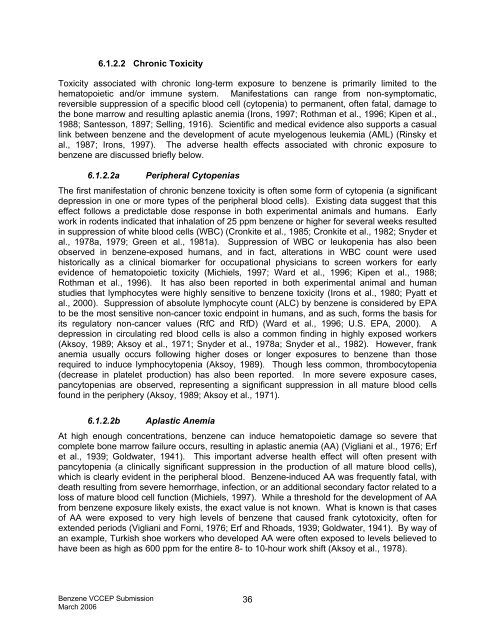(VCCEP) Tier 1 Pilot Submission for BENZENE - Tera
(VCCEP) Tier 1 Pilot Submission for BENZENE - Tera
(VCCEP) Tier 1 Pilot Submission for BENZENE - Tera
You also want an ePaper? Increase the reach of your titles
YUMPU automatically turns print PDFs into web optimized ePapers that Google loves.
6.1.2.2 Chronic Toxicity<br />
Toxicity associated with chronic long-term exposure to benzene is primarily limited to the<br />
hematopoietic and/or immune system. Manifestations can range from non-symptomatic,<br />
reversible suppression of a specific blood cell (cytopenia) to permanent, often fatal, damage to<br />
the bone marrow and resulting aplastic anemia (Irons, 1997; Rothman et al., 1996; Kipen et al.,<br />
1988; Santesson, 1897; Selling, 1916). Scientific and medical evidence also supports a casual<br />
link between benzene and the development of acute myelogenous leukemia (AML) (Rinsky et<br />
al., 1987; Irons, 1997). The adverse health effects associated with chronic exposure to<br />
benzene are discussed briefly below.<br />
6.1.2.2a Peripheral Cytopenias<br />
The first manifestation of chronic benzene toxicity is often some <strong>for</strong>m of cytopenia (a significant<br />
depression in one or more types of the peripheral blood cells). Existing data suggest that this<br />
effect follows a predictable dose response in both experimental animals and humans. Early<br />
work in rodents indicated that inhalation of 25 ppm benzene or higher <strong>for</strong> several weeks resulted<br />
in suppression of white blood cells (WBC) (Cronkite et al., 1985; Cronkite et al., 1982; Snyder et<br />
al., 1978a, 1979; Green et al., 1981a). Suppression of WBC or leukopenia has also been<br />
observed in benzene-exposed humans, and in fact, alterations in WBC count were used<br />
historically as a clinical biomarker <strong>for</strong> occupational physicians to screen workers <strong>for</strong> early<br />
evidence of hematopoietic toxicity (Michiels, 1997; Ward et al., 1996; Kipen et al., 1988;<br />
Rothman et al., 1996). It has also been reported in both experimental animal and human<br />
studies that lymphocytes were highly sensitive to benzene toxicity (Irons et al., 1980; Pyatt et<br />
al., 2000). Suppression of absolute lymphocyte count (ALC) by benzene is considered by EPA<br />
to be the most sensitive non-cancer toxic endpoint in humans, and as such, <strong>for</strong>ms the basis <strong>for</strong><br />
its regulatory non-cancer values (RfC and RfD) (Ward et al., 1996; U.S. EPA, 2000). A<br />
depression in circulating red blood cells is also a common finding in highly exposed workers<br />
(Aksoy, 1989; Aksoy et al., 1971; Snyder et al., 1978a; Snyder et al., 1982). However, frank<br />
anemia usually occurs following higher doses or longer exposures to benzene than those<br />
required to induce lymphocytopenia (Aksoy, 1989). Though less common, thrombocytopenia<br />
(decrease in platelet production) has also been reported. In more severe exposure cases,<br />
pancytopenias are observed, representing a significant suppression in all mature blood cells<br />
found in the periphery (Aksoy, 1989; Aksoy et al., 1971).<br />
6.1.2.2b Aplastic Anemia<br />
At high enough concentrations, benzene can induce hematopoietic damage so severe that<br />
complete bone marrow failure occurs, resulting in aplastic anemia (AA) (Vigliani et al., 1976; Erf<br />
et al., 1939; Goldwater, 1941). This important adverse health effect will often present with<br />
pancytopenia (a clinically significant suppression in the production of all mature blood cells),<br />
which is clearly evident in the peripheral blood. Benzene-induced AA was frequently fatal, with<br />
death resulting from severe hemorrhage, infection, or an additional secondary factor related to a<br />
loss of mature blood cell function (Michiels, 1997). While a threshold <strong>for</strong> the development of AA<br />
from benzene exposure likely exists, the exact value is not known. What is known is that cases<br />
of AA were exposed to very high levels of benzene that caused frank cytotoxicity, often <strong>for</strong><br />
extended periods (Vigliani and Forni, 1976; Erf and Rhoads, 1939; Goldwater, 1941). By way of<br />
an example, Turkish shoe workers who developed AA were often exposed to levels believed to<br />
have been as high as 600 ppm <strong>for</strong> the entire 8- to 10-hour work shift (Aksoy et al., 1978).<br />
Benzene <strong>VCCEP</strong> <strong>Submission</strong><br />
March 2006<br />
36





